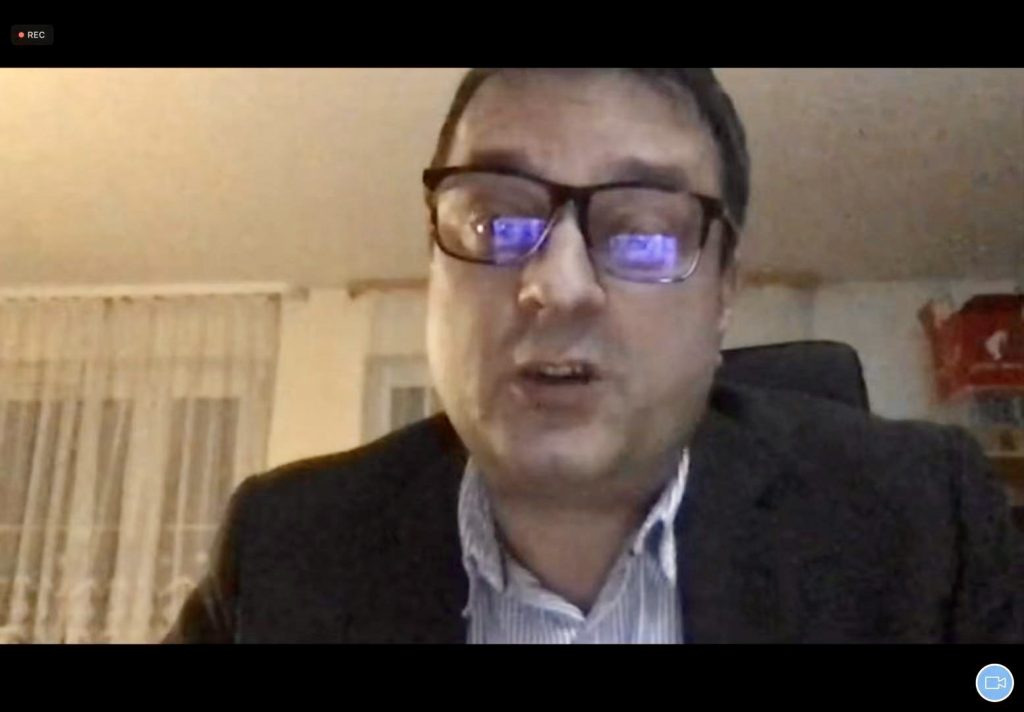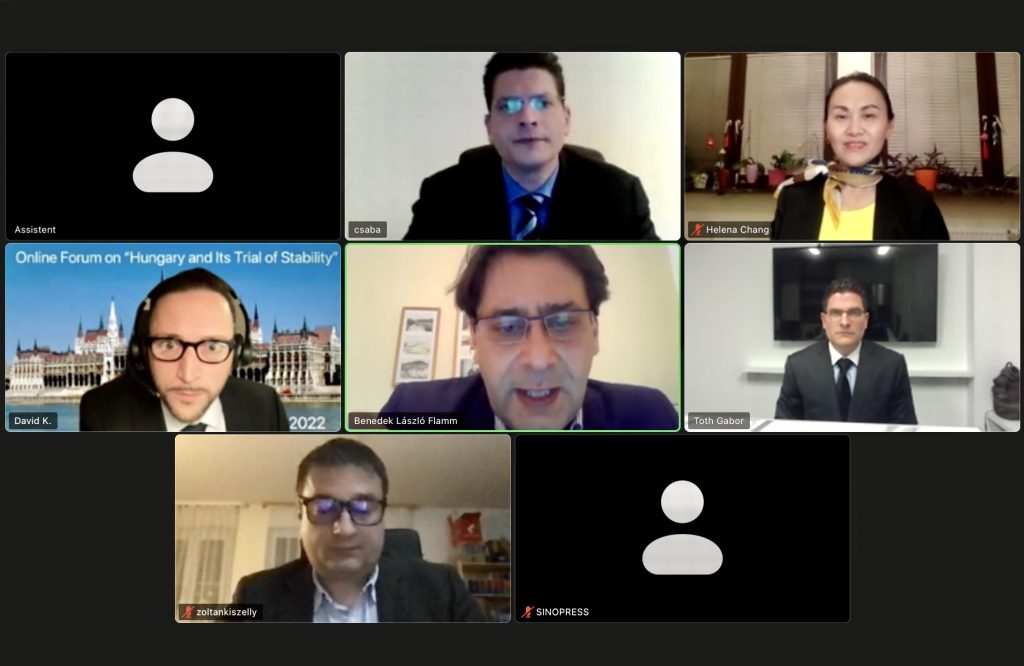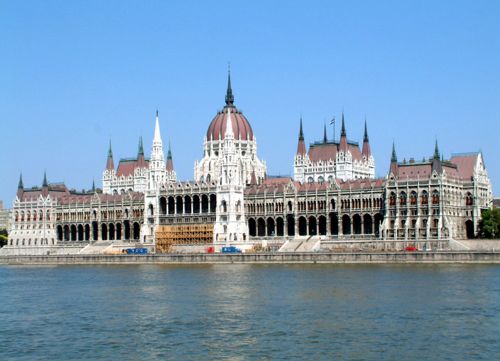
On April 3, 2022, Viktor Orbán won a fourth successive term as Hungary’s prime minister. With nearly 86% of the vote counted on Sunday night, Fidesz was winning 135 seats in the 199-member parliament, crushing a six-party opposition who aimed at unseating Orbán with Márki-Zay as its designated PM candidate.
Co-invited by SINOPRESS based in Vienna and Dr. FLAMM based in Budapest, Zoltán KISZELLY, Director of the Centre for Political Analyses of the Századvég Foundation, Budapest, joined the Zoom Conference on March 29, 2022 as a panelist and inspired the participants by elaborating the following questions.

SINOPRESS: What are the most challenging social and political conflicts at home for Prime Minister Orbán?
Mr. KISZELLY: Hungary as a member of the European Union (EU) and NATO, its society is affected by the two major challenges of the early 21th century: the economic and social effects of the Covid-pandemic and threats of the Ukraine war. The membership in these Western integration organizations is an important frame for the problem solution and room for maneuvers of the Hungarian government.
The moderate right government in Budapest with Mr. Viktor Orbán as a European leader represents an alternative inside these organizations, who is often seen as a person: “Who is not the one, who is right, but the one, who will have right”. As his government set a highly recognized alternative pattern during the 2015 migration crisis, and the Covid-pandemic, many are carefully watching the handling of the Ukraine crisis.
In the mainstream western media, it is often mentioned that “if you need orientation regarding the future of Europe, then listen to French president Emanuel Macron or Hungarian PM Viktor Orbán”. Back to 2015 when the overpopulation from the neighboring continents poured into Europe looking for a better life, the Hungarian government sticked to the Schengen protocol, and protected the outside borders of the Schengen Zone by keeping the freedom of movement inside intact with a border fence and a sever border regime. Since then, many European countries follow the Hungarian example, from Norway to the Spanish enclaves Ceuta in North-Africa and raise border fences.
During the Covid-pandemic, the Hungarian government enabled the emergency use by distributing the Russian Sputnik V and the Chinese Sinopharm vaccine, which allowed faster vaccination. 3 million people more had gained protection in this way. Hungarian economy and public life returned from lockdown in Mai 2021, some 1-2 month earlier than most of EU member states. This resulted in a 7.1% GDP-growth last year. The government used the tax revenues to restore the full 13. month pension payment in early 2022. Parents received in February 2022 a tax refund linked to the average income, that could be as much as 2,000 euros. The young adults till 25 years are from January free from paying the 15% flat income tax.
All this set a pretext for an also successful 2022 year, with high expectations for continued GDP-growth. After the pandemic, full employment was reached, and following Poland (2 million); Czech Republic (half a million) and Slovakia (200,000) Hungary was starting to welcome some 40,000 Ukrainian guest workers, especially in the building industry and manufacturing. Currently there are 80,000 open jobs.
In the USA, we see an income inflation, while in Europe we see an energy-related inflation. The Green New Deal policy of the European Commission with its focus on renewable energy and carbon taxes for fossil energy propellered the energy prices last autumn and winter. The Hungarian government introduced last November a price cap for fuel (480 Forint, ca. 1,25 euro) which shall remain in force for a period of three months (prolonged till 15th of May). In January, a price cap on prices of six basic food products (sunflower oil, flour, sugar, chicken breast, 2,8% milk, pig thighs) to protect the retired and poor people. As ca. 85% of Hungarians are homeowners and many are buying their home on mortgage, the government introduced an interest rate cap on home mortgages. The Hungarian National Bank urged mortgage borrowers to choose long term (5-10 year) interest rate periods for the pre-inflation low rates, as in the current inflation period this mortgage terminates, the interest rate cap helps prolong the mortgage lower than at market level. This supports especially young families with children, who benefitted from family subsidies.
The opposition joined forces and formed a six party “rainbow” coalition from the far left to the far right. Recently, we saw this pattern of defeating popular patriotic leader all over the world. This pattern is more successful, if the challenger is a “moderate conservative”, as it was the case in the previous Israeli and Czech elections.
In Hungary, the mayor of a country town, Hódmezővásárhely, Mr Péter MÁRKI-ZAY won the pre-election campaign held by the opposition parties prior to the national elections and defined the election programme. He seems to adopt the European Commission’s Green New Deal, suggesting “world market prices” for utility and fossil energy at all, which endangers the cap on utility costs introduced in 2013. Mr. Márki-Zay expressed his expectation that “world market prices” would attract (or better force) Hungarians to consume less “water, gas and power” that would result in “real decrease of consumption and so in utility costs”. He also suggested a health care system that people have to pay for, as “there is nothing for free”.

SINOPRESS: In the wake of the Ukraine crisis, what could be the new geopolitical situation in Europe? Which diplomatic role could Hungary see to play in the future?
Mr. KISZELLY: The Ukraine war changed the whole political and social landscape and is jeopardizing the fragile economic recovery.
In Hungary, many see the Ukraine war as the end of globalization. I would say as the end of spontaneous globalization starting with the WTO-membership of China. We start the transition towards a controlled globalization, which could end in a cold war between the West and the East. As the Covid-pandemic didn’t provide the reason but the catalyst for many processes, we can see the Ukrainian war as an even bigger catalyst.
To understand the war in the Ukraine, we first have to take a look at the tectonical shifts in the geopolitical landscape of Europe and the Middle-East. Starting in the 2010s, we could observe the building of zones of influence of the respective world and regional powers. The EU is the home market for Germany, the coalition treaty of the new German government envisions — after German role model — the Federal States of Europe, the backyard market of the German economy. The USA wants to unite the American and the European markets, to double the size of the GDP than China and uses the new TTIP negotiations to build a common market on the base of the Green New Deal. The EU-US Trade and Technology Council (TTC) talks started last September in Pittsburgh (PA) and are going to define the rules for “green” technology of the West.
All products produced by “non-green” technologies will be subject of a carbon tax, aiming to reduce the disadvantage of higher green productions costs in the West by making products of fossil energy base more expensive. The EU and USA common market would be the G1 pole of the World economy, so – at least in this view – the other pole, China, would be always half as strong (G2).
Turkey builds its sphere of influence among the Turk states. Hungary is an observing member of the Turk Nations’ Council and hosts in Budapest the European office of this council. Saudi-Arabia is building its alliance among the Sunni countries and Iran among the Shia-countries. China has established its Belt and Road Initiatives (BRI). Russia is surrounded by these growing spheres of influence and “had to act” to catch the remaining “free” or available countries, as Belarus and Ukraine.
Hungary, as a member-state of the EU and NATO, is economically heavily dependent on the western trade. Around 70% of exports are going to the West, mainly to Germany. The idea of “Opening to the East”, what later become the “Global Opening” project, aims to increase the volume of eastern trade significantly and not to reduce the volume of the western one. A success in this program would result – according to the theory of the communicating vessels – in a balanced export scheme. Hungarians learned in history that one sided economic dependence can be transformed into political dependence.
The Ukraine war affects Hungary’ policy on Opening to the East, as the EU widens its economic sanctions on Russia even more than those after the 2014 Crimea-crisis. The Hungarian government pointed out that the immediately cut of Russian fossil energy supply would result in a collapse of the economy and agriculture. So, for Budapest the cut of flow of Russian fossil energy is a “red line”. As Germany, Italy, Austria, Bulgaria and Slovakia are also nearly as dependent on Russian energy, the Hungarian position is not isolated inside the EU. Budapest agreed to the European Commission’s plan to gain independence from Russian fossil energy till 2025, but stressed its concerns regarding this ambitious deadline. PM Orbán visited Russian president Putin on February 1st in Moscow, and they agreed on an option for an increase of the volume of Russian gas deliveries by one billion cubic meter a year on top of the annually 4,5 billion, which was agreed last autumn on the basis of an 10+5 years of long-term contract.
Hungary sets here an example, too. The EU’s Brussels Commission urges the member states to conclude short-term contracts, but mayor producers like Qatar or Russia are interested in long-term contracts. As the EU wants to become carbon-neutral by 2050, fossil oil is seen as a source of energy for the maximum of 25 years. Producers need long-term contracts to assure the return of their investments of bank loans.
Hungary undertook in the last decade a lot to become more independent from Russian gas. So, the gas pipelines were transformed into reverse operational mode, thus bilateral transport was enabled. The new LNG-terminal on the Croatian island of Krk in the Adriatic see allows the annual delivery of 2 billion cubic meters of gas to Hungary. Right now, the Ukrainian government is using this way from Croatia through Hungary and Slovakia. The new Baltic Stream pipeline became operational in October 2021 and delivers gas from as far, as Azerbaijan via Turkey, Bulgaria, North-Macedonia and Serbia. This pipeline is used for the Russian gas transport, too.
The only Hungarian nuclear power plant in the town of Paks (called Paks 1) has a remaining operational period of 10 years, so a new nuclear plant is needed to replace the ca. 40% share in power production. The contract for the new nuclear plant (“Paks”2) was prepared by a former socialist government. In the Hungarian population, the majority is open for using nuclear power. The present war and the sanctions on the relevant constructing company, Rosatom, endangered the project. Finland already canceled a similar Russian project; Bulgaria and Turkey are still interested in such projects. One shall see whether or not German and French tech suppliers remain on board.
Hungarian tourism benefitted from the acceptance of the Russian Covid-vaccine Sputnik V as Russian tourists are allowed to enter Hungary with a single negative PCR-test and no need to test every 2-3. day. The war in Ukraine and the ban of flights reduced the promising inflow of Russian tourists.
The war interrupted the land railway link between China and Hungary via Russia and Ukraine. The start of operation of the East-West Intermodular Terminal in the border town of Fényeslitke with a capacity of 1 million TEU/year has to be postponed.
The Hungarian government sees the war as a “proxy war between the USA and Russia” and wants to stay out. The Hungarian position is not to deliver weapons but to provide humanitarian aid and to welcome the Ukrainian war refugees. The Hungarian government differentiates between illegal migrants, who cross, often be the cases, continents to arrive in Europe and do not cooperate with the authorities. War refugees are running for their lives, crossing only one border and are cooperating with the authorities. In the first month of the Ukraine war, already half a million refugees arrived in Hungary, an average of 30-40% of them remaining here, the rest travelling to relatives or friends living in other European countries.
While the Hungarian opposition alliance would go further and send weapons and ammunition to Ukraine, and would introduce sever sanctions, e.g., the immediate cut of Russian fossil energy import, it is important for the Hungarian government to emphasize the diplomatic and political solutions of the crisis, in addition to sharing the consensual positions of both the EU and NATO.
(END)


Be the first to comment on "Mr. KISZELLY on Hungary and Its Trial of Stability"